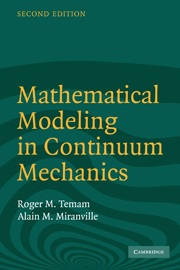Book contents
- Frontmatter
- Contents
- Preface
- A few words about notations
- PART I FUNDAMENTAL CONCEPTS IN CONTINUUM MECHANICS
- PART II PHYSICS OF FLUIDS
- PART III SOLID MECHANICS
- PART IV INTRODUCTION TO WAVE PHENOMENA
- 18 Linear wave equations in mechanics
- 19 The soliton equation: the Korteweg–de Vries equation
- 20 The nonlinear Schrödinger equation
- Appendix: The partial differential equations of mechanics
- Hints for the exercises
- References
- Index
18 - Linear wave equations in mechanics
Published online by Cambridge University Press: 06 July 2010
- Frontmatter
- Contents
- Preface
- A few words about notations
- PART I FUNDAMENTAL CONCEPTS IN CONTINUUM MECHANICS
- PART II PHYSICS OF FLUIDS
- PART III SOLID MECHANICS
- PART IV INTRODUCTION TO WAVE PHENOMENA
- 18 Linear wave equations in mechanics
- 19 The soliton equation: the Korteweg–de Vries equation
- 20 The nonlinear Schrödinger equation
- Appendix: The partial differential equations of mechanics
- Hints for the exercises
- References
- Index
Summary
Before studying, in Chapters 19 and 20, some nonlinear wave equations occuring in mechanics, we consider in this chapter several linear wave equations arising in mechanics and study some fundamental aspects of the corresponding vibration phenomena.
In Section 18.1, we start by recalling the fundamental wave equations that appeared in the previous chapters: the equations of linear acoustics that appeared in Chapter 8 in the context of fluid mechanics and the Navier equation that appeared in Chapter 13 in the context of linear elasticity. We also specialize these equations to specific phenomena such as sound pipes and vibrating cords and membranes.
In Section 18.2, we show how to solve the one-dimensional wave equation considered in the whole space ℝ. Then, in Section 18.3, we are interested in bounded intervals, leading us to introduce the normal (self-vibration) modes, which also depend on the boundary conditions; some typical examples of boundary conditions are considered and the corresponding eigenmodes made explicit. In Section 18.4, we show how to solve the wave equation in a general bounded domain of ℝ3 by using the corresponding eigenmodes again; however, in this case, the solution is not complete because we cannot compute the eigenmodes, in general. Finally, in the last section of this chapter, Section 18.5, we give some indications on other important vibration phenomena such as superposition of waves, beats, and wave packets.
Returning to the equations of linear acoustics and of linear elasticity
Returning to the wave equations of linear acoustics
The equations of linear acoustics have been introduced in Chapter 8, Section 8.4.
- Type
- Chapter
- Information
- Mathematical Modeling in Continuum Mechanics , pp. 271 - 288Publisher: Cambridge University PressPrint publication year: 2005

